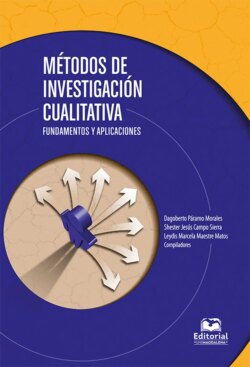Читать книгу Métodos de investigación cualitativa. Fundamentos y aplicaciones - Dagoberto Páramo Reales - Страница 29
На сайте Литреса книга снята с продажи.
Referencias
ОглавлениеBlumer, H. (1954). What is wrong with social theory?. American Sociological Review, 19, 3-10.
_________. (1966). Social implications of the thought of G.M. Mead. American Journal of Sociology, 71.
_________. (1969). Symbolic interactionism: Perspective and method. New Jersey, United States: Prentice Hall.
Creswell, J. (1994). Research design. Qualitative and quantitative approaches. Califormia, United States: Sage.
Denzin, N. (1978). The research act. A theoretical introduction to sociological methods. New York, United States: Mc Graw Hill.
Denzin, N. and Lincoln, Y. S. (1994). Introduction: Entering the field of qualitative research. In N. K. Denzin and Y. S. Lincoln (Eds.), Handbook of qualitative research (pp. 1-17). California, United States: Sage.
_________. (2000). The policies and practices of interpretation. In N. K. Denzin y Y. S. Lincoln (Eds.), Handbook of qualitative research (pp. 897-992). California, United States: Sage.
Denzin, N. K. (1997). Interpretative ethnography. Ethnographical practice for the 21st century. London, England: Sage.
Devers, K. (1999). How will we know ‘good’ qualitative research when we see it? Beginning the dialogue in health services research. Health Services Research, 34(5).
Echeverría, R. (2003). Ontología del lenguaje. Jesaez Editor. Santiago, Chile: Comunicaciones Noreste.
Garfinkel, H. (1967). Studies in Ethnomethodology, Englewood. New York, United States: Prentice Hall.
Glaser, B. and Strauss, N. (1967). The Discovery of Grounded Theory. Chicago, United States: Adeline press.
González, F. (2004). Los métodos etnográficos en la investigación cualitativa en educación. Maracaibo, Venezuela: Instituto Pedagógico de Maracay.
Guba, E.G. (1978). Toward a methodology of naturalistic inquiry in educational evaluation. Monograph Series in Evaluation N. 8. Los Angeles, United Estates: University of California.
_________. (1981). Criteria for assessing the trustworthiness of naturalistic inquiries”. Educational Communication and Technology Journal, 29(2), 75-91.
Guba, E.G. and Lincoln, Y.S. (1981). Effective evaluation: Improving the usefulness of evaluation results through responsive and naturalistic approaches. San Francisco, United States: Jossey-Bass.
_________. (1982). Epistemological and methodological bases of naturalistic inquiry”. Educational Communication and Technology Journal, 30(4), 233-252.
_________. (1989). Fourth generation evaluation. California, United States: Sage.
_________. (1990). Can there be a human science?. Person Centered Review, 5(2), 130-154.
Hall, E. (1977). Beyond culture. New York, United States: Anchor Books.
Hirschman, E. (1990). Secular Immortality and the American Ideology of Affluence. Journal of Consumer Research, 16, 344-359.
_________. (1992). The Consciousness of Addiction: Toward a General Theory of Compulsive Consumption. Journal of Consumer Research, 19, 155-179.
Holbrook, M. (1989). Seven Routes to Facilitating the Semiotics Interpretations of Consumption Symbolism and Marketing Imagery in Works of Art: Some Tips for Wildcats. Advances in Consumer Research, 16, 420-425.
Holbrook, M. B. and kuwahara, T. (1998). Collective stereographic photo essays: An integrated approach to probing consumption experiences in depth. International. Journal of Research in Marketing, 15, 201-221.
Husserl, E. (1967). The thesis of the natural standpoint and its suspension. In J.J. Kockelmans (Ed.), Phenomenology. New York, United States: Garden City.
Leininger, M. (1994). Evaluation criteria and critique of qualitative research studies. In J. M. Morse (Ed.), Critical Sisees in Qualitative Research Methods. California, United States: Sage.
Levy, S. J. (1996). Stalin the amphisbaena. Journal of Consumer Research, 23, 163-176.
Lincoln, Y.S. and Guba, E.G. (1985). Naturalistic inquiry. California, United States: Sage.
Lincoln, Y.S. (1990). Toward a categorical imperative for qualitative research. Qualitative Inquiry in Education: The continuum Debate, 1, 277-295.
_________. (1995). Emerging criteria for quality in qualitative and interpretive research. Qualitative Inquiry, 1, 275-289.
Martínez, M. (2004). La etnometodología y el interaccionismo simbólico. Sus aspectos metodológicos específicos. Caracas, Venezuela: Universidad Simón Bolívar.
McDaniels, C. y Gates, R. (1999). Investigación de mercados contemporánea. Ciudad de México, México: International Thomson Publishing.
Miles, M. y Huberman, M. (2003). Analyse des données qualitatives. Bruxelles, Belgique: De Boeck Université Éditions.
Moustakas, C. (1994). Phenomenological Research Methods. Thousands Oaks, United States: Sage.
Páramo, D. (2002). A mí no me hablen de mercadeo. Bogotá, Colombia: Balaje Editores.
_________. (2000). La etnografía, una aproximación antropológica al estudio del comportamiento del consumidor. Revista Colombiana de Marketing, 1(1), 1-23.
_________. (2004). El fenómeno de consumo y el consumo en marketing. Revista Convergencia, 34, 221-250.
_________. (2007). La literatura en la enseñanza del mercadeo. Un experimento. En Epistemología, investigación y educación en las Ciencias Administrativas. Bogotá, Colombia: ASCOLFA.
Páramo, D. y Ramírez, E. (2017). Etnomarketing, la dimensión cultural del marketing. Bogotá, Colombia: Klasse Editores.
Patton, M. (2002). Qualitative Research y Evaluation Methods. California, United States: Sage Publications.
Schutz, A. (1964). Studies in social theory. La Haya, Países Bajos: Martinus Hijhoff.
Thompson, C., Pollio, H. and Locander, W. (1994). The Spoken and the Unspoken: A Hermeneutic Approach to understanding the Cultural Viewpoints that Underlie Consumers’ Expressed. Journal of Consumer Research, 21, 432-452.
Van Manen, M. (1990). Researching lived experience: Human science for action sensitive pedagogy. New York, United States: Routledge.
Wallendorf, M. and Brucks, M. (1993). Introspection in consumer research: Implementation and implications. Journal of Consumer Research, 20, 339-359.
Wolf, M. (1982). Sociologías de la vida cotidiana. Madrid, España: Ediciones Cátedra.
